
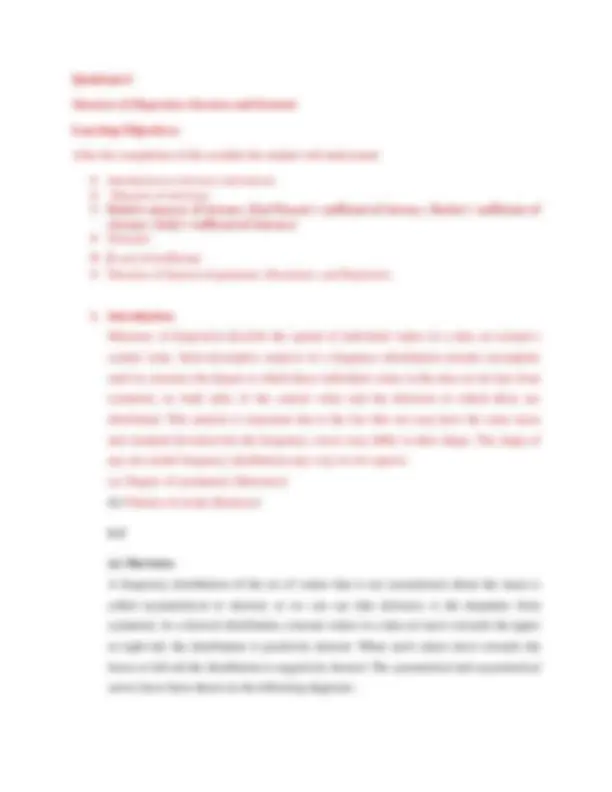
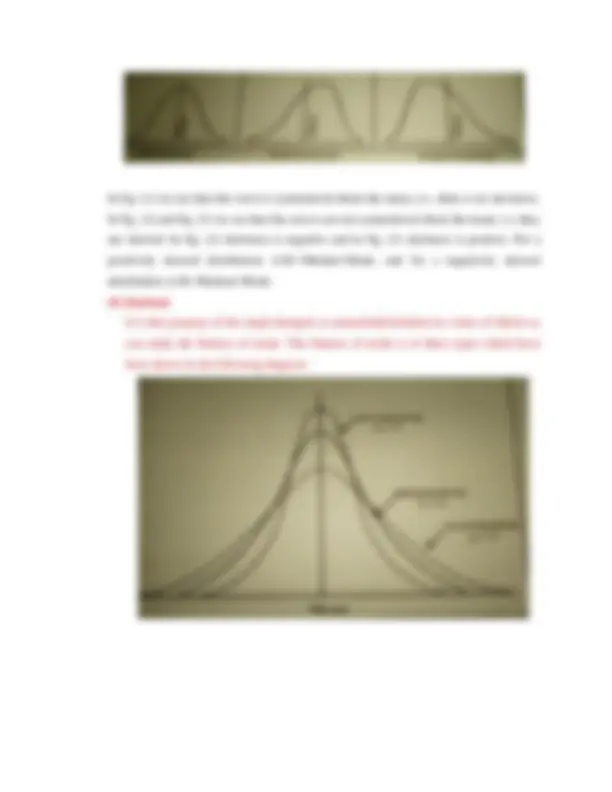
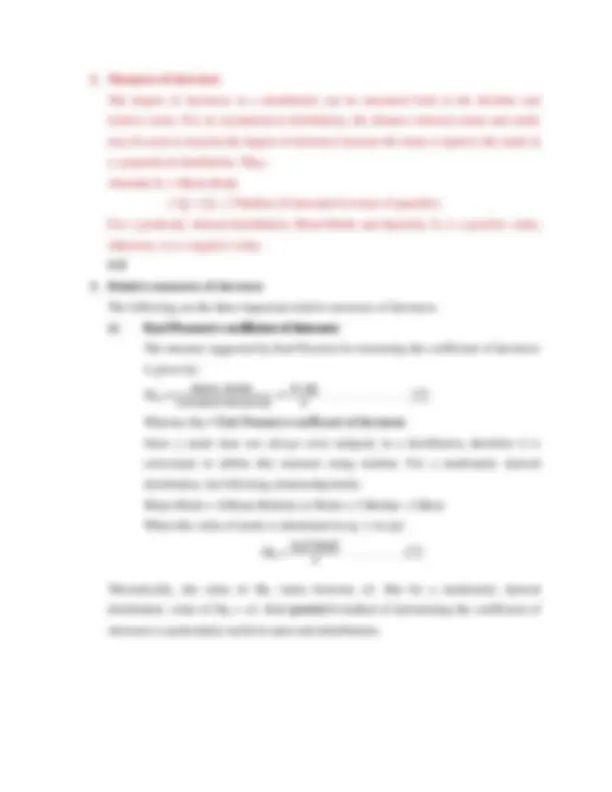
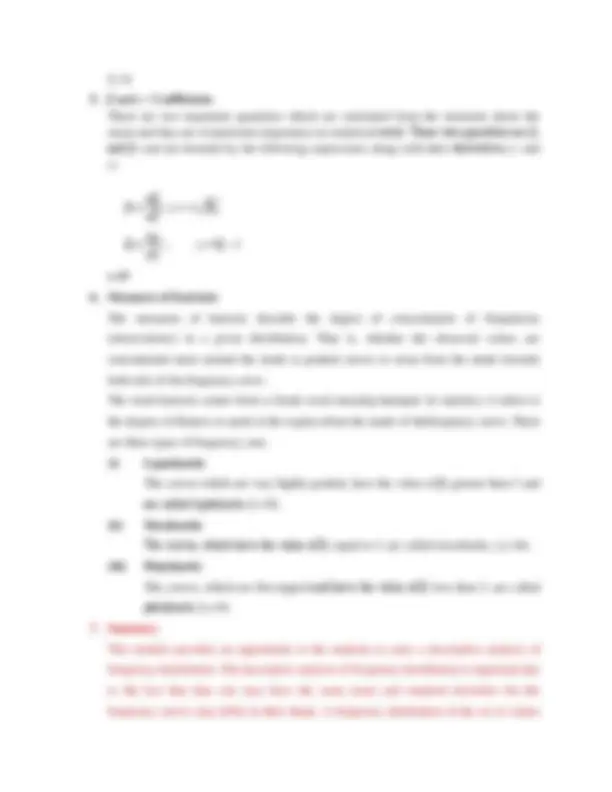
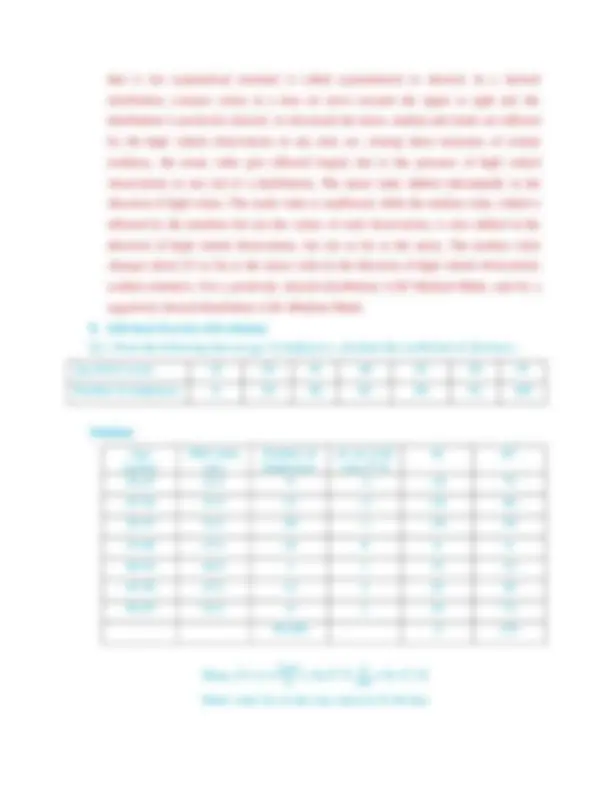
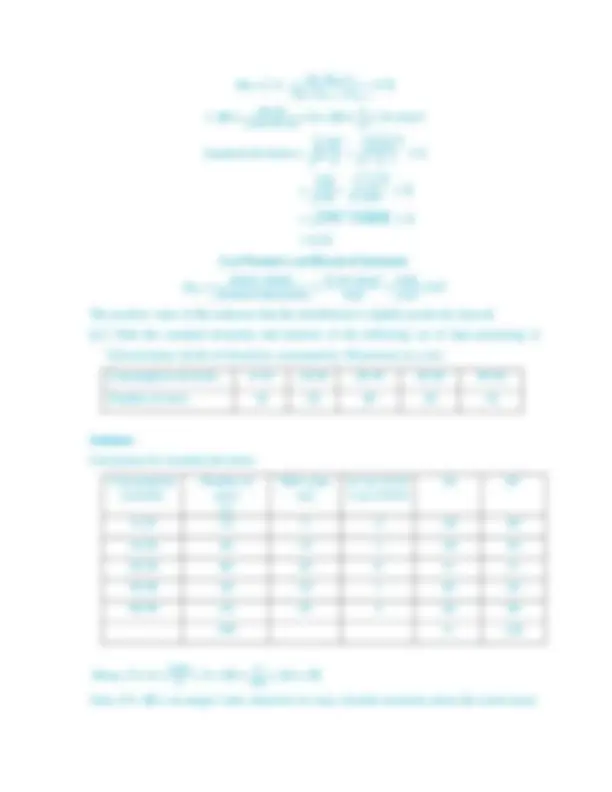


Study with the several resources on Docsity

Earn points by helping other students or get them with a premium plan


Prepare for your exams
Study with the several resources on Docsity

Earn points to download
Earn points by helping other students or get them with a premium plan
Community
Ask the community for help and clear up your study doubts
Discover the best universities in your country according to Docsity users
Free resources
Download our free guides on studying techniques, anxiety management strategies, and thesis advice from Docsity tutors
A module from maharaja agrasen university and central university of himachal pradesh on the topic of measures of dispersion: skewness and kurtosis. The module covers the principles of skewness and kurtosis, their measures, and their significance in data analysis. It includes self-check exercises with solutions and learning objectives for students.
What you will learn
Typology: Thesis
1 / 11

This page cannot be seen from the preview
Don't miss anything!







Paper: 15-Quantitative Techniques for Management Decisions
Module: 8- Measures of Dispersion: Skewness and Kurtosis
Principle Investigator Prof. S P Bansal Vice Chancellor Maharaja Agrasen University, Baddi
Co-Principle Investigator Prof. YoginderVerma Pro–ViceChancellor Central University of Himachal Pradesh. Kangra. H.P.
Paper Coordinator Prof. Pankaj Madan Dean- FMS Gurukul Kangri Vishwavidyalaya, Haridwar
Content Writer Prof. Pankaj Madan Dean-FMS GurukulKangriVishwavidyalay, Haridwar
Items Description of Module
Subject Name Management
Paper Name Quantitative Techniques for Management Decisions
Module Title Measures of Dispersion: Skewness and Kurtosis
Module Id 8
Pre- Requisites Basic mathematical operations
Objectives An Introduction to skewness and kurtosis Measures of skewness Relative measures of skewness Moments β and γ Coefficient Measures of kurtosis
Keywords Skewness, Kurtosis, Leptokurtic, Mesokurtic, Platykurtic, Symmetrical, Asymmetrical
Module- 8 Measures of Dispersion: Skewness and Kurtosis Introduction Measures of Skewness: Absolute measures of skewness, Relative measures of skewness (Karl Pearson’s coefficient of skewness, Bowley’s coefficients of skewness, Kelly’s coefficient of skewness)
Coefficient Kurtosis: Measures of kurtosis (Leptokurtic, Mesokurtic, and Platykurtic) Summary Self-Check Exercise with solutions
In fig. (1) we see that the curve is symmetrical about the mean, i.e., there is no skewness. In fig. (2) and fig. (3) we see that the curves are not symmetrical about the mean, i.e. they are skewed. In fig. (2) skewness is negative and in fig. (3) skewness is positive. For a positively skewed distribution A.M.>Median>Mode, and for a negatively skewed distribution A.M.<Median<Mode. (b) Kurtosis It is that property of the single-humped or unimodaldistribution by virtue of which we can study the flatness of mode. The flatness of mode is of three types which have been shown in the following diagram.
2. Measures of skewness The degree of skewness in a distribution can be measured both in the absolute and relative sense. For an asymmetrical distribution, the distance between mean and mode may be used to measure the degree of skewness because the mean is equal to the mode in a symmetrical distribution. Thus, Absolute Sk = Mean-Mode = Q 3 + Q 1 – 2 Median (if measured in terms of quartiles) For a positively skewed distribution, Mean>Mode and therefore Sk is a positive value, otherwise, it is a negative value. **S-
Whereas Skp = Karl Pearson’s coefficient of skewness. Since a mode does not always exist uniquely in a distribution, therefore it is convenient to define this measure using median. For a moderately skewed distribution, the following relationship holds: Mean-Mode = 3(Mean-Median) or Mode = 3 Median- 2 Mean When this value of mode is substituted in eq. 1 we get
Theoretically, the value of Skp varies between ±3. But for a moderately skewed distribution, value of Skp = ±1. Karl pearson’s method of determining the coefficient of skewness is particularly useful in open-end distributions.
μ 2 ´= (^) 𝑁^1 ∑ 𝑓(𝑋 − 𝐴)^2 = (^) 𝑁^1 ∑ 𝑓𝑑^2
μ 3 ´= (^) 𝑁^1 ∑ 𝑓(𝑋 − 𝐴)^3 = (^) 𝑁^1 ∑ 𝑓𝑑^3
μ 4 ´= (^) 𝑁^1 ∑ 𝑓(𝑋 − 𝐴)^3 = (^) 𝑁^1 ∑ 𝑓𝑑^4
Here μ 1 ´,μ 2 ´,μ 3 ´and μ 4 ´…….μu´ are known as first, second, third, fourth,………….rth moments about A.
s-
Moments about the Origin
It is represented by the symbol mr. Where, mr = (^) 𝑁^1 ∑ 𝑓𝑋𝑟 m1 = (^) 𝑁^1 ∑ 𝑓𝑋 m2 = (^) 𝑁^1 ∑ 𝑓𝑋^2 m3 = (^) 𝑁^1 ∑ 𝑓𝑋^3 m4 = (^) 𝑁^1 ∑ 𝑓𝑋^4
s-
Central Moments
The moments about the Arithmetic Mean (X͞) are known as Central Moments, and are represented by μr. The rth^ moment about the mean is defined asX͞ μr = (^) 𝑁^1 ∑ 𝑓(𝑋 − X͞)r^ = (^) 𝑁^1 ∑ 𝑓𝑥𝑟 μ 1 = (^1) 𝑁 ∑ 𝑓(𝑋 − X͞), μ 2 = (^) 𝑁^1 ∑ 𝑓(𝑋 − X͞)^2 , μ 3 = (^) 𝑁^1 ∑ 𝑓(𝑋 − X͞)^3 , μ 4 = (^) 𝑁^1 ∑ 𝑓(𝑋 − X͞)^4
There are two important quantities which are calculated from the moments about the mean and they are of particular importance in statistical work. These two quantities are β 1 and β 2 and are denoted by the following expressions along with their derivatives γ 1 and γ 2.
β 1 = 𝜇^3
2
β 2 = 𝜇 𝜇^4 22
s-
6. Measures of Kurtosis The measures of kurtosis describe the degree of concentration of frequencies (observations) in a given distribution. That is, whether the observed values are concentrated more around the mode (a peaked curve) or away from the mode towards both tails of the frequency curve. The word kurtosis comes from a Greek word meaning humped. In statistics, it refers to the degree of flatness or peak in the region about the mode of thefrequency curve. There are three types of frequency cure. (i) Leptokurtic The curves which are very highly peaked, have the value of β 2 greater than 3 and are called leptokurtic (γ 2 >0). (ii) Mesokurtic The curves, which have the value of β 2 equal to 3, are called mesokurtic, (γ 2 =0). (iii) Platykurtic The curves, which are flat-topped and have the value of β 2 less than 3, are called platykurtic (γ 2 <0) 7. Summary This module provides an opportunity to the students to carry a descriptive analysis of frequency distribution. The descriptive analysis of frequency distribution is important due to the fact that data sets may have the same mean and standard deviation but the frequency curves may differ in their shape. A frequency distribution of the set of values
Standard deviation = √∑ 𝑓𝑑 𝑁 2 − √(∑ 𝑓𝑑𝑁 )^2 × ℎ
= √^275100 − √( 100 −5)
2 × 5 = (^) √2.75 − 0.0025 × 5 = 8. Karl Pearson’s coefficient of skewness:
The positive value of Skp indicates that the distribution is slightly positively skewed. Q.2. Find the standard deviation and kurtosis of the following set of data pertaining to kilowatt hours (kwh) of electricity consumed by 100 persons in a city. Consumption (in kwh) 0-10 10-20 20-30 30-40 40- Number of users 10 20 40 20 10
Solution Calculation for standard deviation Consumption (in kwh)
Number of users (f)
Mid-value (m)
d= (m-A)/ = (m-25)/
-fd fd^2
0-10 10 5 -2 -20 40 10-20 20 15 -1 -20 20 20-30 40 25 0 0 0 30-40 20 35 1 20 20 40-50 10 45 2 20 40 100 0 120
Mean, 𝑥 = 𝐴 + ∑ 𝑓𝑑𝑁 × ℎ = 25 + 1000 × 10 = 25
Since 𝑥 = 25 is an integer value, therefore we may calculate moments about the actual mean
μr = (^) 𝑁^1 ∑ 𝑓(−X͞)r^ = (^) 𝑁^1 ∑ 𝑓(𝑚 − 𝑥)𝑟
Let d =𝑚−𝑥͞ℎ or (m- 𝑥)=hd. Therefore
μr = hr^ 𝑁^1 ∑ 𝑓𝑑𝑟; h= width of class intervals
Mid-value Frequency (^) d=𝑚 10 −^25 fd fd^2 fd^3 fd^4 5 10 -2 -20 40 -80 160 15 20 -1 -20 20 -20 20 25 40 0 0 0 0 0 35 20 1 20 20 20 20 45 10 2 20 40 80 160 100 120 0 360
Moments about the origin A= μ 1 =h (^) 𝑁^1 ∑ 𝑓𝑑) =10 × 1001 = μ 2 =h^2 1 𝑁 ∑ 𝑓𝑑^2 = (10)^2 1001 × 120 = 120 μ 3 =h^3 𝑁^1 ∑ 𝑓𝑑^3 = (10)^3 × 1001 × 0 = 0 μ 4 =h^4 𝑁^1 ∑ 𝑓𝑑^4 = (10)^4 × 1001 × 360 = 36,000.
Karl Pearson’s measure of kurtosis is given by β 2 = 𝜇 𝜇^4 22
and therefore γ 2 = β 2 -3 = 2.5-3= -0. Since β 2 <3(or γ 2 <0), distribution curve is platykurtic.